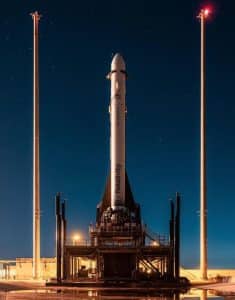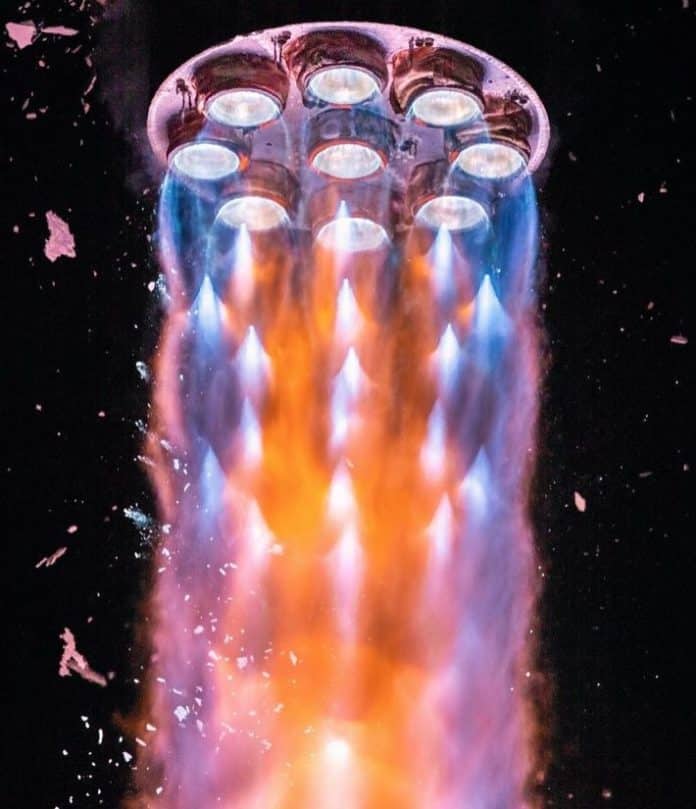Cape Canaveral Space Force Station, Fla. – The world of commercial spaceflight got a little bit bigger last week with the “successful failure” of Terran 1 on March 23rd. The launch of Terran 1, on a test mission called “Good Luck, Have Fun,” marked the first-ever flight for Relativity Space, a newcomer to the commercial spaceflight industry. All eyes were on the launch not only because Terran 1 was the world’s first 3D-printed rocket but because it was powered by a new type of rocket engine called Aeon. Aeon engines are the first US-produced rocket engines to be powered by a combination of methane and liquid oxygen.
It was evident to launch observers that this launch was not like any other. As the nine Aeon engines ignited, Terran 1 rose from Pad 16 on a crisp pillar of blue flame, a product of the new methane fuel mixture. One observer compared the ignition to watching a blow torch. The flight proceeded smoothly as Terran 1 accelerated and passed through Max Q, the stage of flight with the highest aerodynamic pressure. Passing safely through Max Q was considered a milestone in the flight, as it was a major test of the structure of the rocket. At about two minutes and forty-five seconds into the flight, as the rocket neared 100 miles in altitude, the main engines cut off (MECO), and the first stage separated right on schedule.
It was then that a major problem began. Only six seconds after booster separation, the single Aeon second-stage engine briefly lit but failed to keep burning. The engine failure resulted in the rocket decelerating and failing to achieve orbit. The upper portion of the rocket came down over the Atlantic Ocean about four hundred miles to the east of Cape Canaveral. The rocket carried no crew or payload.
This was the third launch attempt for Terran 1, having been scrubbed twice before for technical issues. The previous attempt on Saturday, March 11, was called off after an automated computer abort just one-half second before liftoff. The March 11 attempt was followed by a second attempt to launch that day. That attempt was aborted because of low fuel pressures in the second stage. Relativity officials have not yet commented on the cause of the second stage failure in Wednesday’s launch attempt.
It is not uncommon for rockets to experience a failure during their first test flight. Even with the failure to reach orbit, Relativity Space was able to compile a wealth of data that can be used to ensure the success of subsequent flights. In a Twitter statement released following the launch, a Relativity spokesman said, “Today’s launch proved Relativity’s 3D-printed rocket technologies that will enable our next vehicle, Terran R. We successfully made it through Max-Q, the highest stress state on our printed structures. This is the biggest proof point for our novel additive manufacturing approach. Today is a huge win, with many historic firsts. We also progressed through Main Engine Cutoff and Stage Separation. We will assess flight data and provide public updates over the coming days.”
Like the Terran 1 rocket itself, Relativity’s Aeon engines are 3D printed. The process requires fewer individual parts and less complex assemblies within the engine. Officials at Relativity believe that 3D-printed engines save time, money, and weight and represent the future of space hardware manufacturing. The engines, known as “methalox” engines, operate on a fuel mixture that includes methane and liquid oxygen. Many consider methane the rocket fuel of the future because it burns cleaner and provides more thrust than the kerosene/liquid oxygen rocket fuels in use today, according to the company. The Aeon engine is a simpler design and requires far less ground support equipment. China attempted a launch with its own methalox engine last December, but that launch failed when the second stage did not provide sufficient thrust to reach orbit.
Relativity Space is one of several startups in the commercial spaceflight industry seeking to develop a reusable medium-lift rocket. The company was founded in 2015 by Tim Ellis, the current CEO, and CTO Jordan Noone, with the goal of developing 3D-printed launch vehicles and engines for widespread use in the rapidly growing commercial space industry.


